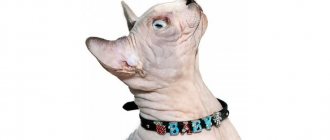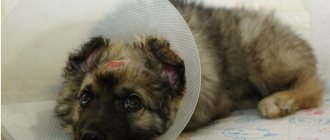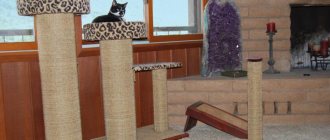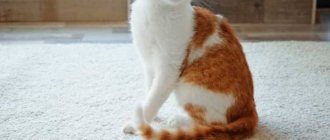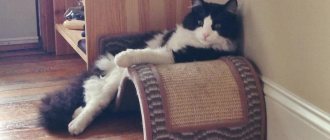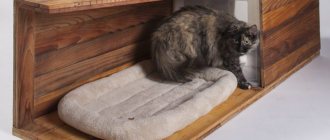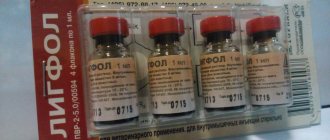What is the collar for?
First of all, this accessory makes it clear that the cat it is wearing is not a street stray, but a pet. You can hang a keychain or capsule with your contacts on the collar so that your pet can be returned to you without any problems if it suddenly gets lost during a walk.
Typically, the following materials are used to make collars:
- nylon;
- Genuine Leather;
- velvet;
- velours;
- metal.
When choosing a material, consider some features. For example, you should not put metal chains on your cat in the rain or winter.
Simple leather collar
Clasps for collars can be either metal or plastic. The second option is better: fastex can adjust the length of the collar down to a millimeter; this does not require holes in the strap. There are even special safety fasteners that can snap off when pulled if the cat gets caught on a branch, for example.
If this type of fastener seems expensive to you, you can, when making your own collar, connect the ends with rough Velcro. You can also carefully trim the collar in several places (if it is made of fabric or thin leather) so that it breaks under critical tension.
So, we figured out the materials and accessories. Now a few words about how to calculate the size of a product. The optimal length of the collar is calculated using the formula “neck volume plus two fingers.” If you don't have a measuring tape on hand, you can use a string and mark the required distance with knots on it.
The collar should fit tightly and at the same time not squeeze the throat. A cat can easily remove a dangling collar over its head, or catch it on a fence, branch or cabinet handle. If the strap presses, breathing will become difficult and blood circulation will be impaired. Calculate the length of the collar so that the tip protruding from under the clasp is short.
How to make your pet's ammunition with your own hands
Don't worry that pet walks will put a strain on your budget due to the purchase of equipment. All these things can be done with your own hands from scrap materials. Handmade leashes and collars have a number of undeniable advantages compared to purchased ones.
- Saving money.
- No need to drive or go to the pet store.
- The owner can show creativity when sewing products.
- Your pet's ammunition will be unique.
- Equipment tailored to your pet’s individual parameters will fit better than store-bought ones.
The disadvantages include the following:
- You need to spend time. If you are not used to making things with your own hands, you may need a lot of it.
- You are responsible for the reliability of the ammunition. If you don't make good enough fastenings, you risk losing your pet.
Making a collar for a cat
So, you can’t do without a collar with an address tag on a walk, so it’s better to start making ammunition with it. To do this, you can use leather, fabric (nylon, velvet, velor) or improvised materials. The clasp for the collar can be made of metal or plastic; you can also sew Velcro or ties instead (which is less reliable). To work you will need:
- scissors;
- thread and needle;
- a thimble and an awl (especially if you are sewing leather or thick fabric);
- sewing machine - if available;
- measuring tape or string with handle:
- fabric (leatherette, jeans, other available materials) or nylon sling - your choice;
- accessories for decorating the collar (beads, rhinestones - optional);
- purchased fastex fastener, metal buckle or Velcro;
- half ring for attaching a leash or address card.
First you need to determine the length of the future collar. To do this, measure the circumference of the animal's neck, and then add a distance the size of two fingers (about 5 cm) to this measurement. This is done so that the collar does not put pressure on the cat's neck. Next, add another 5–7 cm to adjust the fastener.
The comfortable width of a cat collar, in turn, is usually about 2–2.5 cm.
Based on these parameters, a strip of fabric is cut out or a suitable nylon sling is selected.
Nylon sling is the simplest material for making a collar.
The end of the tape is passed through one of the two parts of the fastener, folded over and secured with a seam. The ring for attaching the carabiner is also sewn on at this stage, immediately after the clasp.
This is what the collar looks like after part of the fastener and the half ring are sewn to the sling
The other, remaining free end of the sling is threaded through the double-slot buckle and the second half of the fastener, which is not yet sewn. The sling is then pulled through the buckle again, forming a loop. The “tail” of the sling, threaded through the buckle, is bent back 3 cm and secured with a seam.
In order for the fastenings to be reliable, it is better to lay a double seam
If making a collar with a fastex clasp seems difficult, you can simply sew a buckle and ring to one end of the product, and make holes for the clasp at the other end of the collar with an awl. Whatever option you choose, there is always room for imagination - the collar can be decorated with decorative elements to your taste.
Video: options for making a collar yourself
Making a leash
A leash for a cat is made according to the same principle as a collar.
You need to find it at home or buy a sling and carabiner. The length of the future leash depends on your height and on how far you allow your pet to move away (usually 1.5 - 2 meters).
One edge of the sling is threaded into a carabiner, pulled inward by 2–4 cm, folded over and sewn on. For maximum reliability, you should first make a seam along the edge of the curved sling and a seam near the carabiner. Between the two parallel seams formed, two more seams are sewn - crosswise.
A leash for a cat is made according to the same principle as a collar.
The handle of the leash is formed at the other end of the line. It looks like a loop, the width of which will depend on the size of the owner’s palm. The loop is secured with threads in exactly the same way as the end of the leash with a carabiner was sewn on.
Instead of threads, you can use a special hole punch and rivets, and instead of a sling, you can use a thin leather belt or rope.
Video: how to quickly make a leash with your own hands
Sew a harness
A cat harness can be made from straps, thick rope, fabric, old jeans (other clothing), or even knitted from yarn.
To sew the simplest models of this accessory you will need the following:
- material (fabric, strap, rope);
- paper or oilcloth for patterns;
- chalk or soap;
- threads, needle, tailor's pins, scissors;
- an awl and a thimble if the fabric is durable;
- half ring for attaching a carabiner.
The harness, like the collar, should fit snugly on the animal’s body without squeezing anything. Check - one finger should fit between the straps and the cat's body.
X-shaped harness (figure-of-eight harness)
An X-shaped harness consists of two or three parts - pieces of belts or ropes.
X-shaped harness is only suitable for calm animals
Making a figure-eight harness is easier than any other type of this equipment. Based on the measurements of the chest and neck circumference of the animal, two pieces of the strap (rope) are cut out with an allowance of approximately 2 cm on each side. If necessary, the cut parts are processed along the edges with threads and then fastened at the intersection using threads or a button. A ring is sewn to the intersection point for attaching a leash carabiner. To strengthen the fixation, another strap (strap) is sewn between the x-shaped parts along the cat’s belly.
By the way: you can use a thin women's strap as a harness.
You can use a strap as a figure-of-eight harness
H-shaped harness (vest)
To make this model, measurements are taken of the circumference of the cat's neck and chest, as well as the distance between the paws.
Next, a pattern is drawn on tracing paper or a sheet of paper, transferred to the fabric and cut out.
Before cutting a harness out of fabric, it is better to draw a sketch on paper
The product is stitched along the entire length.
Then a strip of braid is sewn onto the back of the harness along the back, onto which a ring or loop is sewn to attach the leash carabiner.
If desired, the harness can be decorated with ribbons, appliqués or rhinestones, and a collar or butterfly bow can be sewn on. This way it will turn from a useful device into a stylish accessory.
The harness-vest can be decorated to your taste
Harness
Its difference from the H-shaped harness is the presence of an additional jumper under the animal’s chest. To cut out this part, you need to measure the distance from the base of the neck to the space between the pet's front legs.
Harness in the shape of a harness provides additional reliability
Video: master class on making a harness
Master class on making an accessory
Like any handicraft, making a collar is a very exciting and interesting activity. We offer you a simple and easy process that will not take much of your time.
- First of all, choose the right fabric. It can be any color you like, but the main condition is that it must be dense.
- Prepare a fastener that is easy to use (we discussed their options above), a needle and thread. To decorate the collar, you can take beautiful stones, beads or beads, preferably the same size.
- Measure the volume of the cat's neck with a centimeter. From the selected material, cut a narrow strip, no more than 2 cm.
- Glue or sew pebbles onto the prepared base so that the distance between them is the same. Carefully attach the clasp so that the collar can be easily removed and put on at any time.
When choosing fabric for a collar, pay attention to the density of the material
Using this template, you can easily make a collar of any kind, giving free rein to your imagination. The main thing is to remember a few simple rules:
- Do not use very heavy jewelry. It will be uncomfortable for the cat to walk in a collar that bends it to the ground. It is better to decorate the product with fewer stones or beads.
- If you want to decorate the collar with ribbons, secure them so that they do not interfere with the cat's walking. Carefully secure the tape on all sides, otherwise it may unravel, blocking the cat's view, or, worse, get caught on something.
- When choosing material for a collar, pay close attention to its composition. Some types of fabrics can cause allergies in both humans and cats. Leather is considered the optimal material for a collar.
Tip: To find out if your pet is allergic to fabric, place the selected material near the cat for a while. If the animal does not react for a long time, you can use this fabric to make a collar with your own hands.
Buy or make it yourself?
Leashes for cats today can be bought at any pet store or online store, and you can also order inexpensive models from China. These products have a size chart, some of them are even equipped with an adjustment system: if the purchased harness is slightly too big for your pet, you can tighten the straps.
The stores offer a wide range of harnesses made from different materials: these can be leather or fabric straps, elastic nylon bands, suede and fleece models. Additionally, leashes with a length of up to 3 meters are purchased for the products, allowing the freedom-loving pet to calmly explore a new territory under the supervision of the owner.
But not all cats are suitable for purchased harnesses - standard products may not be the right size, and then the money will be wasted. In addition, these pets perceive new odors quite negatively, especially for products from China.
Sometimes even several washes do not help rid the product of the specific aroma that furry pets sensitively sense. The best option is to make a cat harness with your own hands, or even better if you make this accessory from your own worn-out items.
Some more creative options
The example we showed is only a basis that you can use using your imagination. You can make an original, glamorous and unusual collar using simple tips and available tools.
Make a brutal accessory with spikes for your cat. For this you will need:
- silicone wrist bracelet;
- thorns;
- needle with thread.
Grab the decorative spike with a needle and thread and sew it firmly to the bracelet. Sew the remaining spikes in the same way, leaving a distance of 2-3 cm between them. Make sure that the gaps are the same.
Leather collar with spikes
The collar is ready. Its simplicity lies in the fact that it does not require a fastener: the silicone of the bracelet stretches quite well. True, such a collar is suitable for a small kitten or cat. It is better not to wear this accessory for a large animal.
If you are seriously passionate about crafts and are not afraid to try something new, use more complex options. For example, you can weave a collar from strong threads or thin strips of leather using the Shamballa technique, which is very popular in the manufacture of such accessories. It is also easy to knit or crochet a collar or weave it using the macrame technique. Remember that the threads should be soft so as not to cause discomfort to the cat when moving.
You can make fun embroidery along the length of the collar. These could be flowers, cats, or even the name of your pet. Any embroidery technique is suitable, from cross stitch to satin stitch. Bead weavers can please their cats with original, bright jewelry worthy of real princesses.
Useful tips
- Cats are more timid, more active and flexible than dogs. If you plan to walk your pet on a leash, buy or sew a harness. It secures the animal’s body well and leaves little chance for escape. You will also have to gradually accustom your pet to a harness.
- Do not delay in training your kitten to use a collar or harness. The older the animal, the more difficult it is to accustom it to foreign objects on its body.
If the cat comes into the family as an adult, you will have to be patient. Perhaps he will agree to wear only an anti-parasitic collar. The harness and leash will remain gathering dust in the closet.
- A cat over 10 years old will prefer a long nap to a walk on a leash.
- Objects on the animal's body can cause allergies. At the first signs, immediately remove the accessory and consult a doctor.
Cats are independent creatures. No matter how much the owner would like to take a morning or evening promenade with his beloved pet on a leash, perhaps this will remain a dream. Or the animal will turn out to be a minimalist - no collars or harnesses. Only impeccably licked wool.

